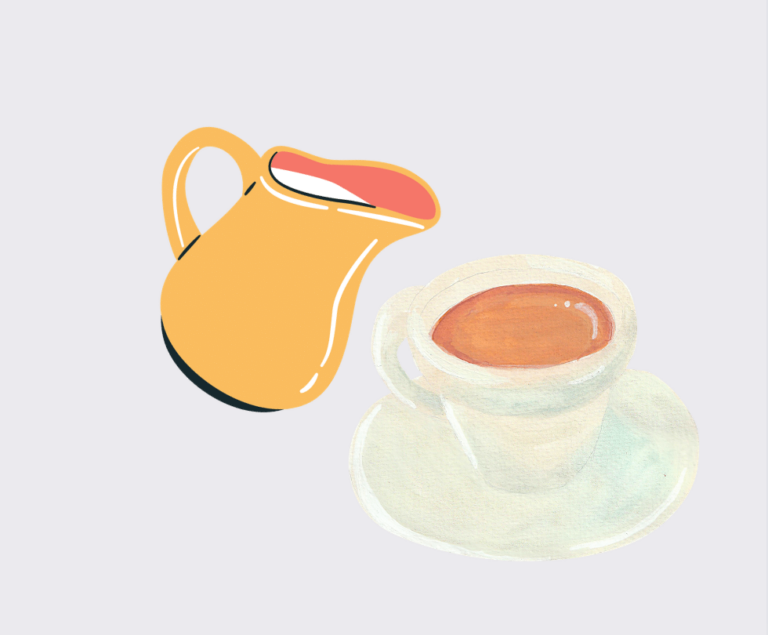
This post may contain affiliate links. As an Amazon Associate and a partner of other brands, I get a small commission if you purchase through my links, at no extra cost from you.
Making a great cafe latte doesn’t come without the knowledge and skill of steaming milk.
If you want to learn how to steam milk at home, this guide will provide some essential guidelines to get you started on the right foot.
So why might someone want to learn how to steam milk?
The answer is simple: while some cafes may offer free refills on coffee, steamed milk is not always included in this arrangement, so it’s best for beginners to learn how to do it themselves.
Let’s dive right into the process and the best way to steam milk.
Types of Steamed Milk
Everyone knows that steamed milk makes for an excellent latte.
However, did you know that there are actually different types of steamed milk?
This type of milk requires more time and technique in order to make it light and foamy enough to create these designs.
It should be served in a glass and not a cup because the foam will not keep its shape if it is poured directly onto the coffee.
The texture of this type of milk is slightly denser than latte art milk, but it provides you with nice bubbles and stretchy micro-foam that you get to enjoy in your coffee.
A latte is basically steamed milk with foam on top and no espresso shot. It’s best to use a pitcher in order to avoid spilling when pouring.
So now that you’re familiar with the types of steamed milk, let’s move on to the next section!
How to Steam Milk – Equipment and Tools Required
In order to steam milk, you’ll need a couple of tools and equipment.
Let’s go over these items step by step:
1. Milk Frothing Pitcher
This is one of the most important items that you can get for steaming your milk.
In fact, it is actually used specifically for steaming since pouring regular milk directly from the jug will only waste a lot of it due to spills and drips.
Instead, use a pitcher to safely pour milk into your cup.
2. Steamer
A steam wand is the most essential element of steam.
It’s usually used for cooking and is made up of an accordion-like long handle and a steam head with a small opening at the tip.
3. Milk Frother
A milk frother is a great tool for creating rich and thick foam on your latte.
The more foamy your milk, the more impressive those latte art designs will be!
Although you can use a hand whisk to create the right texture, the frothing pitcher is recommended since it produces more consistent results.
4. Milk Jug
You don’t need to buy an expensive milk jug as long as it’s made of glass and not plastic.
If you want to save money, then I suggest that you go for stainless steel milk jugs.
They don’t rust easily and they are durable enough to withstand harsh conditions like freezing cold weather!
5. Thermometer
You’ll need a thermometer to check the temperature of your milk. If it is too hot, then you’ll have to let it sit for a few minutes until it has cooled down enough.
If it is around the right temperature, then you’re good to go!
Some people also use a digital meat thermometer for this purpose, although the latter is more expensive and may not be worth it unless you do this on a regular basis.
6. Milk
The type of milk you use is not important. In fact, I suggest using non-fat milk if you like to make lattes.
However, if you don’t like the taste, then I suggest using skimmed milk or whole milk to make lattes.
Before we get started I want to clear the air on a slight confusion about frothing and steaming milk.
Let’s see how these two differ.
Frothing vs Steaming Milk
Frothing Milk: When you steam milk, you are actually creating microfoam or a process where tiny bubbles are expanded in the milk.
This creates a foam that resembles a light and airy whipped cream.
Frothing milk will require a special tool called a frother.
A frother is usually made of metal and has a shaft or whisk attached to it.
You can also use a blender or almost any kitchen utensil that has a whisk on the end of it.
Steaming Milk: For steaming milk, the objective is to create a film on the surface of the milk to help prevent it from burning or overcooking while being heated or cooked.
The film also helps with trapping in the scent, aroma, and taste of coffee.
Steaming is part of the preparation for espresso-based drinks like cappuccino, latte macchiato, etc.
Now that this part is cleared, let’s start learning how to steam milk.
Different Ways to Steam Milk
Steam Milk Without A Wand
There are two ways to steam milk: one way is to use a wand and the other is to do it without a wand.
You can steam milk without a wand, but I would strongly recommend that beginners start out with this method.
The method you use depends on your personal preference and skills.
Steaming milk with a wand is easier to do, but it may be difficult for you to do it without one.
So how do you steam milk without a wand? Here’s what you need to know:
This process will help the milk warm up so that when you pour frothed milk, it doesn’t become cold right away!
You can also use a hand whisk if you prefer that method or don’t have enough money to invest in a frother yet!
You can do this by simply pouring it directly into your latte or espresso drink.
Steam Milk With An Espresso Wand
Wands are the best tools to froth or steam milk with due to their powerful steam pressure.
Just plug it into the hole on the top of the machine and turn on the steam function! Simple as that!
I suggest using a wand for any beginner because they’re easy to use and will allow you to create microfoam easily!
For an espresso lover, there are several different types of wands, including stainless steel, plastic, aluminum, premium stainless steel alloy wands for longevity and durability.
Take note of the materials that they’re made of because you may need to replace it on some machines.
Steam Milk Without A Steamer
The next method of steaming milk is one without a steamer. Funny uh? But not impossible!
So, what can you do if you don’t have a steamer but wish to create your latte and cappuccino without one?
Well, you can always use a double boiler.
In this case, what you do is find a bowl that’s big enough to fit your mug or cup.
Fill it up with warm water and place your mug on top of it.
You want to make sure that the bottom of the cup is actually submerged in the water.
The bowl will create a “double boiler” effect, where hot water boils at a lower temperature than the actual steam wand.
This heating process is important for making great lattes and cappuccinos since you want to avoid overheating or burning your milk!
Another thing to note about using a double boiler is that it requires you to have more control over heating time.
Because there are no steam wands, you will have to monitor the milk so it doesn’t become too hot!
Steam Milk in a Microwave
You can also steam milk in the microwave if you have one.
You can steam milk in the microwave if you have a microwave!
There are several things to keep in mind when making lattes and cappuccinos via this method. Some of these include:
As mentioned before, steamed milk is very hot, so watch what you’re doing! You will also need to make sure that you don’t boil your milk completely.
Boiling milk is not good for the health of your latte or cappuccino, so make sure to use it sparingly!
If it’s too hot, then steam won’t be able to form properly and you’ll end up with burnt milk.
Try using bottled water because it will help prevent your milk from getting too hot.
Make sure that there’s enough space for you to be able to use a mini whisk or a hand whisk to froth the milk!
Steam Milk On A Gas Stove
If you want to steam milk without a wand or an espresso machine, then another great way to go is using a gas stove!
There are several things that you should know about using a gas stove for steaming milk:
This means that you’ll want to put your milk in a separate bowl or pot of water.
The water should be hotter than the milk because the steam will condense on the side of the bowl that’s warmer than the milk discoloration won’t occur when steaming milk due to using fat or oils when frothing or steaming.
If your milk isn’t warm enough, then it won’t foam and steam up properly.
Make sure to turn the power on high and be careful when using it.
If you want to steam milk in the microwave, then it’s advisable that you don’t use a gas stove for this purpose.
Then wait until the two mixes together and froth!
Steam Milk With an Espresso Machine
If you already have an espresso machine at home, steaming milk is such a breeze then.
There are many reasons why using your espresso machine is more convenient than using a normal kitchen appliance, but here are some of the main ones:
You Don’t Have To Monitor The Milk Temperature – You can steam milk with an espresso machine without worrying about the temperature of the milk.
Just make sure that it’s hot enough and turn on the steam function!
Avoid Burning Milk With Steam – When steaming milk with an espresso machine, you won’t burn your milk and result in a burnt cappuccino.
Steamed milk will foam up and become microfoam-like if done properly, so make sure to concentrate on getting it right!
Fewer Parts – Steaming milk with an espresso machine is way easier than trying to steam milk in your kitchen by other means.
You don’t have to worry about finding all the parts or anything like that.
It’s all easy, you can make latte and cappuccino right away!
So how do you actually steam milk with your fancy espresso machine?
Well, it’s really simple! You just need to do the opposite of the direction you usually remove your milk frothing wand.
Instead of removing the wand, put it back in and wait for it to heat up.
Then, when frothing is done, pour your milk into your drink!
Types of Coffee Drinks That Need Steamed Milk
The last section to complete this article is to know which coffee drinks have steamed milk in them.
This can be helpful if you’re out ordering yours.
Latte
Latte is a drink that needs steamed milk in it.
Personally, I prefer to use a frothing wand for latte, but the process is the same!
You just have to steam your milk before adding it into your cappuccino for a perfect latte.
Cappuccino
Cappuccino also needs steamed milk poured in it.
The difference is that with a cappuccino, you also need foam on top of the drink like with a latte.
If you’d like to make a cappuccino without having scoops of foam on top of each sip, then use steam in your milk.
Macchiato
Macchiato is a drink that is similar to a cappuccino, but it doesn’t need foam.
It is mostly served in small cups or mugs with a wide base, so frothing isn’t needed for this kind of drink.
If you want to get the best results with steamed milk, then you can just do it before serving and enjoy your macchiato!
Cafe Con Leche
This is a drink that doesn’t need any kind of frothing for the steamed milk.
It’s basically a latte with more foam on top!
Cafe con leche is usually served in tall cups, so make sure to pour your steamed milk carefully to avoid spills or burns!!
That sums up everything you’ll ever need to know about steaming milk.
Have you ever used steam for steaming purposes? Do you use frothing or do you just pour the milk in??
Final Thoughts on How To Steam Milk
Now, that you know how to steam milk properly at home using different steaming methods, all that’s left for you is practice!
You can use one of these methods or combine them both for the best results.
Of course, a quick Google search will give you a ton of ideas!
Happy steaming!






